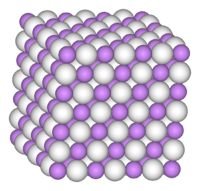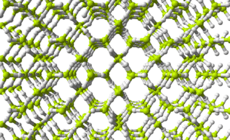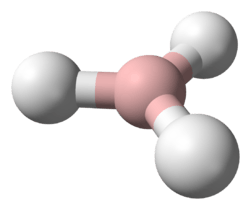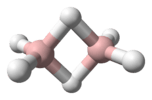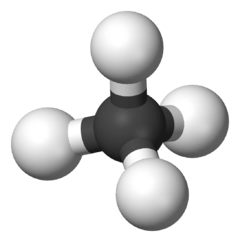Propyne
| | |
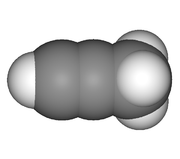 | |
| Names | |
|---|---|
| Preferred IUPAC name
Prop-1-yne[1] | |
| Other names
Propyne Methylacetylene Methyl acetylene Allylene | |
| Identifiers | |
| 74-99-7 | |
| 3D model (Jmol) | Interactive image |
| 878138 | |
| ChEBI | CHEBI:48086 |
| ChEMBL | ChEMBL116902 |
| ChemSpider | 6095 |
| ECHA InfoCard | 100.000.754 |
| EC Number | 200-828-4 |
| MeSH | C022030 |
| PubChem | 6335 |
| |
| |
| Properties | |
| C3H4 | |
| Molar mass | 40.0639 g/mol |
| Appearance | Colorless gas[2] |
| Odor | Sweet[2] |
| Density | 0.53 g/cm3 |
| Melting point | −102.7 °C (−152.9 °F; 170.5 K) |
| Boiling point | −23.2 °C (−9.8 °F; 250.0 K) |
| Vapor pressure | 5.2 atm (20°C)[2] |
| Hazards | |
| Explosive limits | 1.7%-?[2] |
| US health exposure limits (NIOSH): | |
| PEL (Permissible) |
TWA 1000 ppm (1650 mg/m3)[2] |
| REL (Recommended) |
TWA 1000 ppm (1650 mg/m3)[2] |
| IDLH (Immediate danger) |
1700 ppm[2] |
| Except where otherwise noted, data are given for materials in their standard state (at 25 °C [77 °F], 100 kPa). | |
| | |
| Infobox references | |
Propyne (methylacetylene) is an alkyne with the chemical formula CH3C≡CH. It was a component of MAPP gas—along with its isomer propadiene (allene), which was commonly used in gas welding. Unlike acetylene, propyne can be safely condensed.[3]
Production and equilibrium with propadiene
Propyne exists in equilibrium with propadiene, the mixture of propyne and propadiene being called MAPD:
- H3CC≡CH ⇌ H2C=C=CH2
The coefficient of equilibrium Keq is 0.22 at 270 °C or 0.1 at 5 °C. MAPD is produced as a side product, often an undesirable one, by cracking propane to produce propene, an important feedstock in the chemical industry.[3] MAPD interferes with the catalytic polymerization of propene.
Laboratory Methods
Propyne can also be synthesized on laboratory scale by reducing 1-propanol,[4] allyl alcohol or acetone[5] vapors over magnesium.
Use as a rocket fuel
European space companies have researched using light hydrocarbons with liquid oxygen as a relatively high performing liquid rocket propellant combination that would also be less toxic than the commonly used MMH/NTO (monomethylhydrazine/nitrogen tetroxide). Their research showed that propyne would be highly advantageous as a rocket fuel for craft intended for low Earth orbital operations. They reached this conclusion based upon a specific impulse expected to reach 370 s with oxygen as the oxidizer, a high density and power density—and the moderate boiling point, which makes the chemical easier to store than fuels that must be kept at extremely low temperatures. (See cryogenics.)
Organic chemistry
Propyne is a convenient three-carbon building block for organic synthesis. Deprotonation with n-butyllithium gives propynyllithium. This nucleophilic reagent adds to carbonyl groups, producing alcohols and esters.[6] Whereas purified propyne is expensive, MAPP gas could be used to cheaply generate large amounts of the reagent.[7]
Propyne, along with 2-butyne, is also used to synthesize alkylated hydroquinones in the total synthesis of vitamin E.[8]
References
- ↑ Nomenclature of Organic Chemistry : IUPAC Recommendations and Preferred Names 2013 (Blue Book). Cambridge: The Royal Society of Chemistry. 2014. p. 374. doi:10.1039/9781849733069-FP001. ISBN 978-0-85404-182-4.
- 1 2 3 4 5 6 7 "NIOSH Pocket Guide to Chemical Hazards #0392". National Institute for Occupational Safety and Health (NIOSH).
- 1 2 Peter Pässler, Werner Hefner, Klaus Buckl, Helmut Meinass, Andreas Meiswinkel, Hans-Jũrgen Wernicke, Günter Ebersberg, Richard Müller, Jürgen Bässler, Hartmut Behringer, Dieter Mayer, "Acetylene" in Ullmann's Encyclopedia of Industrial Chemistry Wiley-VCH, Weinheim 2007 (doi:10.1002/14356007.a01 097.pub2).
- ↑ Keiser, Edward & Breed, Mary (1895). "The Action of Magnesium Upon the Vapors of the Alcohols and a New Method of Preparing Allylene". The Journal of the Franklin Institute. CXXXIX: 304–309. doi:10.1016/0016-0032(85)90206-6. Retrieved 20 February 2014.
- ↑ Reiser, Edward II. (1896). "The preparation of Allylene, and the Action of Magnesium upon Organic Compounds". The Chemical News and Journal of Industrial Science. LXXIV: 78–80. Retrieved 20 February 2014.
- ↑ Michael J. Taschner, Terry Rosen, and Clayton H. Heathcock (1990). "Ethyl Isocrotonate". Org. Synth.; Coll. Vol., 7, p. 226
- ↑ US patent 5744071, Philip Franklin Sims, Anne Pautard-Cooper, "Processes for preparing alkynyl ketones and precursors thereof", issued 1996-11-19
- ↑ Reppe, Walter; Kutepow, N & Magin, A (1969). "Cyclization of Acetylenic Compounds". Angewandte Chemie International Edition in English. 8 (10): 727–733. doi:10.1002/anie.196907271. Retrieved 26 December 2013.
External links
- NIST Chemistry WebBook page for propyne
- German Aerospace Center
- Nova Chemicals
- CDC - NIOSH Pocket Guide to Chemical Hazards

